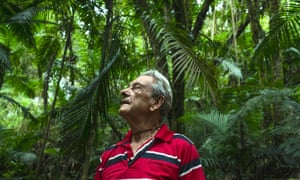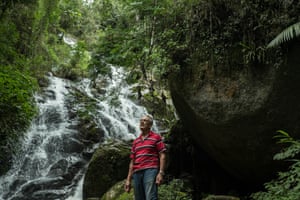Mokichi Okada - Wikipedia
Mokichi Okada
From Wikipedia, the free encyclopedia
Jump to navigationJump to search

Mokichi Okada
Mokichi Okada (岡田茂吉 Okada Mokichi, 23 December 1882 – 10 February 1955) was the founder of the Church of World Messianity, in which he is known by the honorific title Meishū-sama (明主様, lit. "Lord of Light")[1]. He is also the founder of Johrei, a healing ritual that claims to use "divine light" to dissolve the spiritual impurities that are the source of all physical, emotional, and personal problems.
Contents
1Biography
2Nature Farming
3See also
4References
5External links
Biography[edit]
According to his official biography,[2] Okada was born to a poor family in Tokyo and, after many trials and tribulations, eventually made his fortune in the jewellery business.
Initially a follower of Shinto offshoot Oomoto,[3] Okada claimed to have received a special revelation from God in 1926, leading him to found a new religion in 1935 to spread the teachings. Okada soon expanded to open a rehabilitation center centering on the healing powers of light, but it was shut down in 1936 as a violation of the Medical Practitioners' Law (医師法違反).[4]
The Sangetsu (山月) school of ikebana, inspired by Mokichi Okada, was founded in June 1972.[5] The Mokichi Okada Association (MOA) was established in 1980 to continue his work "toward the creation of a new civilization to be undertaken without confining Okada's principles and their implementation within a religious framework" (MOA[6] acquired the status of a legal entity as a limited liability intermediary corporation in 2005, then transferred to one of general corporation in 2009, officially called MOA International Corporation). Much of Okada's extensive art collection is now housed in the MOA Museum of Art in Atami, Japan.
Nature Farming[edit]
Main article: Nature Farming
In 1936, Okada established an agricultural system originally called "no fertilizer farming" or "Nature Farming".[7][8] Offshoots such as the Sekai Kyusei Kyo, promoting "Kyusei nature farming", and the Mokichi Okada Association formed after his death to continue promoting the work in Japan and South-East Asia.[9]
According to the International Nature Farming Research Center in Nagano, Japan, it is based on the theories that:
- Fertilizers pollute the soil and weaken its power of production.
- Pests would break out from the excessive use of fertilizers
- The difference in disease incidence between resistant and susceptible plants is attributed to nutritional conditions inside the body.
- Vegetables and fruits produced by nature farming taste better than those by chemical farming.[10]
See also[edit]
References[edit]
- ^ Arman Hassan, the main antagonist in the anime series Tiger Mask II, is called so by his subordinates.
- ^ Johrei History Archived August 14, 2007, at the Wayback Machine
- ^ JapanFile - the website of Kansai Time Out magazine - Japanese culture, news, events, music, literature, and reporting Archived November 23, 2015, at the Wayback Machine
- ^ "岡田茂吉(1882-1955)". FFortune.net. Retrieved 30 April 2017.
- ^ "sangetsu". Sangetsu.org. Retrieved 30 April 2017.
- ^ "一般社団法人MOAインターナショナル". MOAInternational.or.jp. Retrieved 30 April 2017.
- ^ "Overview of organic agriculture". Kristiansen, P. and Merfield, C. (2006) Overview of organic agriculture. In: Kristiansen, P.; Taji, A. and Reganold, J. (Eds.) Organic Agriculture: a Global Perspective, CSIRO Publishing, Collingwood, pp. 1–23. "Independent developments were occurring in Japan. In 1936, Mokichi Okada began practicing 'nature farming'. Nature farming includes spiritual and well as agronomic aspects with a view to improving humanity."
- ^ Sustainable Agriculture: Definition and Terms. Special Reference Briefs Series no. SRB 99-02, September 1999. Compiled by: Mary V. Gold, Alternative Farming Systems Information Center, U.S. Department of Agriculture
- ^ Setboonsarng, S. and Gilman, J. 1999. Alternative Agriculture in Thailand and Japan. HORIZON Communications, Yale University, New Haven, Connecticut.
- ^ Scientific Proof of Mokichi Okada's Nature Farming Theories by Xu, Hui-lian. Agricultural Experiment Station, International Nature Farming Research Center, Nagano
External links[edit]
MOA International Home Page
Nature Farming
"Nature Farming" was established in 1936 by Mokichi Okada, the founder of the Church of World Messianity, an agricultural system originally called "no fertilizer farming" or 自然農法 (shizen nōhō) in Japanese.[1]
Offshoots such as the Sekai Kyusei Kyo, promoting ‘Kyusei nature farming’, and the Mokichi Okada Association formed after his death to continue promoting the work in Japan and South-East Asia.[2]
ZZ2, a farming conglomerate in South Africa has translated the term to Afrikaans, "Natuurboerdery".[3]
According to the International Nature Farming Research Center in Nagano, Japan,[4] it is based on the theories that:
- Fertilizers pollute the soil and weaken its power of production.
- Pests would break out from the excessive use of fertilizers
- The difference in disease incidence between resistant and susceptible plants is attributed to nutritional conditions inside the body.
- Vegetables and fruits produced by nature farming taste better than those by chemical farming.
The term is sometimes used for an alternative farming philosophy of Masanobu Fukuoka.
Natural Farming[edit]
Another Japanese farmer and philosopher, Masanobu Fukuoka, conceived of an alternative farming system in the 1930s separately from Okada and used the same Japanese characters to describe it.[5] This is generally translated in English as "Natural Farming" although agriculture researcher Hu-lian Xu claims that "nature farming" is the correct literal translation of the Japanese term.[5]
See also[edit]
Bibliography[edit]
- 自然農法解說 / Shizen nōhō kaisetsu by Mokichi Okada. Publisher: 榮光社出版部 Eikōsha Shuppanbu, Tōkyō 1951.
References[edit]
- ^ Sustainable Agriculture: Definition and Terms. Special Reference Briefs Series no. SRB 99-02, September 1999. Compiled by: Mary V. Gold, Alternative Farming Systems Information Center, U.S. Department of Agriculture
- ^ Setboonsarng, S. and Gilman, J. 1999. Alternative Agriculture in Thailand and Japan. HORIZON Communications, Yale University, New Haven, Connecticut.
- ^ Silent, Taurayi, (March 2011). An investigation of natuurboerdery (natural farming) approach : a ZZ2 case study (Thesis). Stellenbosch : University of Stellenbosch.
- ^ Scientific Proof of Mokichi Okada's Nature Farming Theories by Xu, Hui-lian. Agricultural Experiment Station, International Nature Farming Research Center, Nagano
- ^ a b Xu, Hui-Lian (2001). NATURE FARMING In Japan (Monograph). T. C. 37/661(2), Fort Post Office, Trivandrum - 695023, Kerala, India.: Research Signpost. ISBN 81-308-0111-6. Retrieved 6 March 2011.
External links[edit]
| This agriculture article is a stub. You can help Wikipedia by expanding it. |

 녹색평론
녹색평론






